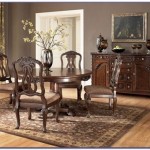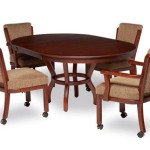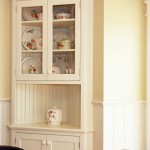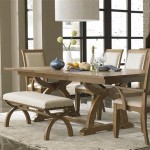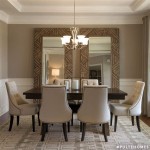The Enduring Appeal of the Distressed Round Dining Room Table
The distressed round dining room table is a furniture piece that seamlessly blends rustic charm with functional design. It offers a unique aesthetic that caters to a variety of interior styles, from farmhouse chic to industrial modern. The "distressed" element, achieved through deliberate aging techniques, lends character and history to the table, creating a focal point in any dining space. The round shape promotes conversation and inclusivity, making it an ideal choice for both intimate family meals and larger gatherings.
Unlike newer, pristine furniture, a distressed table possesses a tangible sense of lived-in comfort. This inherent quality can be particularly appealing in homes striving for a relaxed and welcoming atmosphere. The imperfections, rather than being flaws, are considered features that contribute to the table's individual story and aesthetic value. This allows homeowners to embrace a less formal style while still maintaining a sophisticated design sensibility.
The choice of a round table, as opposed to a rectangular or square one, also holds significant implications for spatial dynamics and social interaction. The absence of corners facilitates easier movement around the table and promotes a sense of equality among diners. This circular design encourages eye contact and open communication, making it a preferred choice for fostering a convivial dining experience.
Key Point 1: Understanding the "Distressed" Aesthetic
The "distressed" look is not simply about damaging furniture. It is a carefully curated process that aims to replicate the effects of age and wear while preserving the structural integrity of the table. This is achieved through a variety of techniques, each contributing to the overall character and appearance. Common methods include:
Chipping and Cracking: These imperfections mimic the natural wear and tear that furniture experiences over time. Artisans often create these effects by carefully chipping away small portions of the paint or finish, revealing the underlying wood. The degree of chipping can vary depending on the desired level of distress, ranging from subtle hints of age to more pronounced rustic characteristics.
Sanding and Weathering: Sanding is used to smooth down certain areas of the table, creating a worn-down effect that suggests years of use. Specific areas, such as edges and corners, are often sanded more aggressively to emphasize this effect. Weathering techniques, such as applying stains or washes, can further enhance the aged appearance, creating variations in color and texture that mimic the effects of exposure to the elements.
Dry Brushing: This technique involves applying a small amount of paint to a dry brush and then lightly brushing it across the surface of the table. This creates a subtle, textured effect that adds depth and dimension to the finish. Dry brushing is often used to highlight specific features of the table, such as carvings or moldings, and to create a sense of faded grandeur.
Antique Glazing: Glazing is the application of a thin, translucent layer of paint or stain that settles into the crevices and details of the table. This creates a subtle shadowing effect that enhances the aged appearance and adds visual interest. Antique glazing can also be used to create a sense of depth and complexity in the finish.
The selection of these techniques is crucial in determining the final aesthetic of the distressed table. The process requires a skilled artisan who understands how to create an authentic and visually appealing aged finish. A poorly executed distressed finish can appear artificial and detract from the overall beauty of the piece.
Key Point 2: Choosing the Right Material and Size
The material composition of a distressed round dining room table significantly affects its durability, appearance, and overall cost. Hardwoods, such as oak, maple, and birch, are popular choices due to their strength and resistance to wear. These woods are also well-suited to distressing techniques and can withstand the deliberate aging process without compromising their structural integrity.
Softwoods, such as pine, are another option, offering a more affordable alternative to hardwoods. Pine is easier to work with and readily accepts distressing techniques, creating a rustic and charming aesthetic. However, pine is more susceptible to scratches and dents than hardwoods, which may be a consideration for high-traffic dining areas.
The size of the table is equally important and should be determined by the size of the dining room and the number of people who will typically be seated around it. A table that is too large will overcrowd the space and make it difficult to move around, while a table that is too small will feel inadequate for larger gatherings.
To determine the appropriate table size, measure the dimensions of the dining room and leave ample space for chairs and walkways. A general rule of thumb is to allow at least 36 inches of space between the edge of the table and the wall or other furniture. This will provide comfortable seating and allow diners to move freely without bumping into each other.
Consider the number of people who will typically use the table. A smaller round table, with a diameter of 48 inches, can comfortably seat four people. A larger round table, with a diameter of 60 inches or more, can accommodate six to eight people. For larger gatherings, consider a table with leaves that can be extended to increase the seating capacity.
Key Point 3: Styling and Complementary Decor
A distressed round dining room table serves as a versatile foundation for a variety of design styles. Its rustic charm can be seamlessly integrated into farmhouse, country, and industrial-inspired interiors. The key to successful styling lies in selecting complementary decor that enhances the table's inherent character and creates a cohesive aesthetic.
For a farmhouse-inspired dining room, consider pairing the distressed table with mismatched chairs in varying styles and finishes. Upholstered chairs with linen or cotton fabrics can add comfort and softness to the space. Incorporate natural elements, such as woven baskets, wooden bowls, and floral arrangements, to enhance the rustic charm.
In a country-style dining room, the distressed table can be complemented by rustic-patterned tablecloths, vintage china, and antique silverware. Consider adding a chandelier with wrought-iron details to create a warm and inviting atmosphere. Incorporate pops of color through the use of artwork, textiles, and decorative accents.
For an industrial-modern dining room, the distressed table can be juxtaposed with sleek metal chairs and minimalist lighting fixtures. Expose brick walls or concrete floors to create a raw, urban feel. Incorporate pops of color through the use of abstract artwork and industrial-inspired accessories.
Lighting plays a crucial role in setting the ambiance of the dining room. Consider a chandelier or pendant light that hangs directly above the table, providing ample illumination for dining and conversation. Dimmer switches can be used to adjust the lighting to create a more intimate atmosphere for special occasions.
The distressed round dining room table’s surface naturally complements certain types of table settings. Rustic stoneware or earthenware dishes can enhance the table's organic feel. Linen napkins and placemats add a touch of elegance. Centerpieces can be kept simple, focusing on natural elements such as branches, flowers, or candles. These elements can enhance the table’s beauty and complement its inherent character without overshadowing its unique charm.
Ultimately, the styling of a distressed round dining room table is a matter of personal preference. The key is to create a cohesive and inviting space that reflects the homeowner's individual style and complements the overall aesthetic of the home.
The practical advantages should also be mentioned. The round shape makes it easy to navigate tighter spaces. The distressed finish is forgiving; minor scratches or spills blend in seamlessly, reducing the pressure to maintain a pristine surface. This makes it a family-friendly option, suitable for households with children or pets.
Investing in a distressed round dining room table is choosing a piece of furniture with inherent character and lasting appeal. Its unique aesthetic and versatile design make it a valuable addition to any dining space. By understanding the nuances of the distressed aesthetic, carefully selecting the right materials and size, and implementing thoughtful styling choices, homeowners can create a dining room that is both beautiful and functional.

Furniture Of America Wicks Distressed White And Gray Wood Round 54 In Pedestal Dining Table Seats 4 Idf 3417gy Rt The Home

Luxury Round Solid Mango Wood Hand Made Dining Table With Black Metal Legs And A Distressed Walnut Finish Four Sizes Etsy

Auletta Distressed Round Dining Table

Gatlinburg Round Dining Set Rustic Furniture

Durango Distressed Wood Round Table Walker Edison

Furniture Of America Auletta Distressed White Round Dining Table With Gray Top Zasa Tulsa Ok

French Style Pedestal Distressed Round Dining Table

Wilmington Rustic Reclaimed Wood Round Pedestal Dining Table

Round Dining Table Farmhouse Style Distressed White Legs Provincial Brown Kitchen Or Room Etsy

Furniture Of America Wicks 5 Piece Round Distressed White And Gray Wood Top Dining Table Set Idf3417gyrt5pc The Home
See Also

